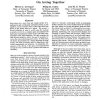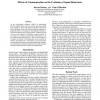AAAI
1990
14 years 1 months ago
1990
Joint action by a team does not consist merely of simultaneous and coordinated individual actions; to act together, a team must be aware of and care about the status of the group ...
AAAI
2006
14 years 1 months ago
2006
This paper addresses the problem of activity recognition for physically-embodied agent teams. We define team activity recognition as the process of identifying team behaviors from...
HCI
2007
14 years 1 months ago
2007
Interaction between two teams with the same team leader and with similar size and goals moved from weekly face-to-face meetings to virtual meetings because of the temporary displac...
AI
2008
Springer
14 years 2 months ago
2008
Springer
A problem of intense interest to many sports fans as a season progresses is whether their favorite team has mathematically clinched a playoff spot; i.e., whether there is no possib...
AIIDE
2008
14 years 2 months ago
2008
As the non-playable characters (NPCs) of squad-based shooter computer games share a common goal, they should work together in teams and display cooperative behaviours that are tac...
AAAI
2008
14 years 2 months ago
2008
This paper addresses the problem of plan recognition for multi-agent teams. Complex multi-agent tasks typically require dynamic teams where the team membership changes over time. ...
ITS
2000
Springer
14 years 4 months ago
2000
Springer
Training teams is an activity that is expensive, time-consuming, hazardous in some cases, and can be limited by availability of equipment and personnel. In team training, the focus...
AGENTCL
2000
Springer
14 years 4 months ago
2000
Springer
The process of cooperative problem solving can be divided into four stages. First, finding potential team members, then forming a team followed by constructing a plan for that tea...
CCGRID
2006
IEEE
14 years 4 months ago
2006
IEEE
- The development and implementation of a 4 quarter course sequence starting in the Spring of the Junior year will be the focus of this paper. The first course focuses on having te...
CSCW
1996
ACM
14 years 4 months ago
1996
ACM
Teams whose members are in close physical proximity often rely on team rooms to serve both as meeting places and repositories of the documents and artifacts that support their pro...



